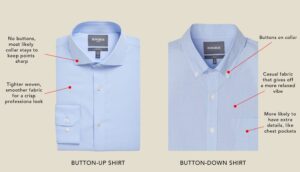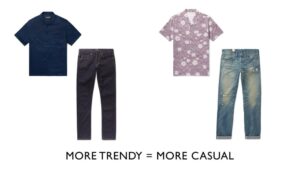
There are enough rules in life as it is. Some, however, are there to help. Like the rules that govern how to dress well. Of course, every man or woman that has an opinion on such things speaks from personal experience – and no doubt what works for one doesn’t always work for another; or what works for one is considered too pedestrian or too avant-garde by another. So, when it comes to dressing, they always have to be taken at face value. They’re solid suggestions rather than the last word on style.
We can gauge the formality using what I call “The More Means More Casual” Rule.
The MORE a piece of clothing has, the MORE it leans casual.
But good fashion tips for men are never to be sniffed at, and, as menswear becomes ever more rich and varied, ever more experimental and abundant, ever more trend-aware, in moments of confusion and self-doubt, it can help to have a valuable fall-back position that cuts through the clutter.
These dressing tips for men tend to be founded in history – they’ve worked for generations, so might well be assumed to work well today too. And they tend to be founded in the obvious, so obvious they’re often overlooked: a preference for good fit, high quality, versatility, good value, lack of extremes and keeping it sober.
BUILD YOUR CUSTOM WARDROBE
To make this business casual wardrobe building process painless, I’ve ranked the styles I’ve used in the past to build business casual wardrobes for my clients by formality.
Just go through the charts below and pick what you like.
Some notes before you start:
How these items were ranked
I used several criteria to rank the formality of the items below.
I first started with long standing men’s rules of formality that we’re all familiar with (a t-shirt is more casual than a button-up. A leather jacket is more casual than a blazer).
I then made adjustments based on real world experience styling men who work in business casual industries over the past 4 years. I didn’t rank ever possible imaginable style out there, just the most common styles I’ve used to build my clients business casual wardrobes.
There will always be exceptions in certain jobs as whether or not something is appropriate. That’s why I highly highly recommend you take the steps in part 1 and speak to HR about dress codes.
This wardrobe guide is all season
I recommend planning your wardrobe with this guide, then making seasons specific swaps using my Spring/Summer guide and Fall/Winter guides when needed.
Start with neutral colors
At the bottom of each item, you’ll notice I recommend specific colors.
We’re sticking with the neutral color rule, as they’re the most versatile. Neutral colors by definition don’t overpower each other, so you can mix and match them infinitely. That means you won’t have to worry about color mixing and matching. If you still need ideas, don’t worry, we’ll be discussing outfit ideas in Part 4.
Once you get the minimum recommendations, feel free to expand
This is optional, but once you get the minimal amount recommended in neutral colors, feel free to add more styles and colors for variety sake.
Written By Peter Nguyen
